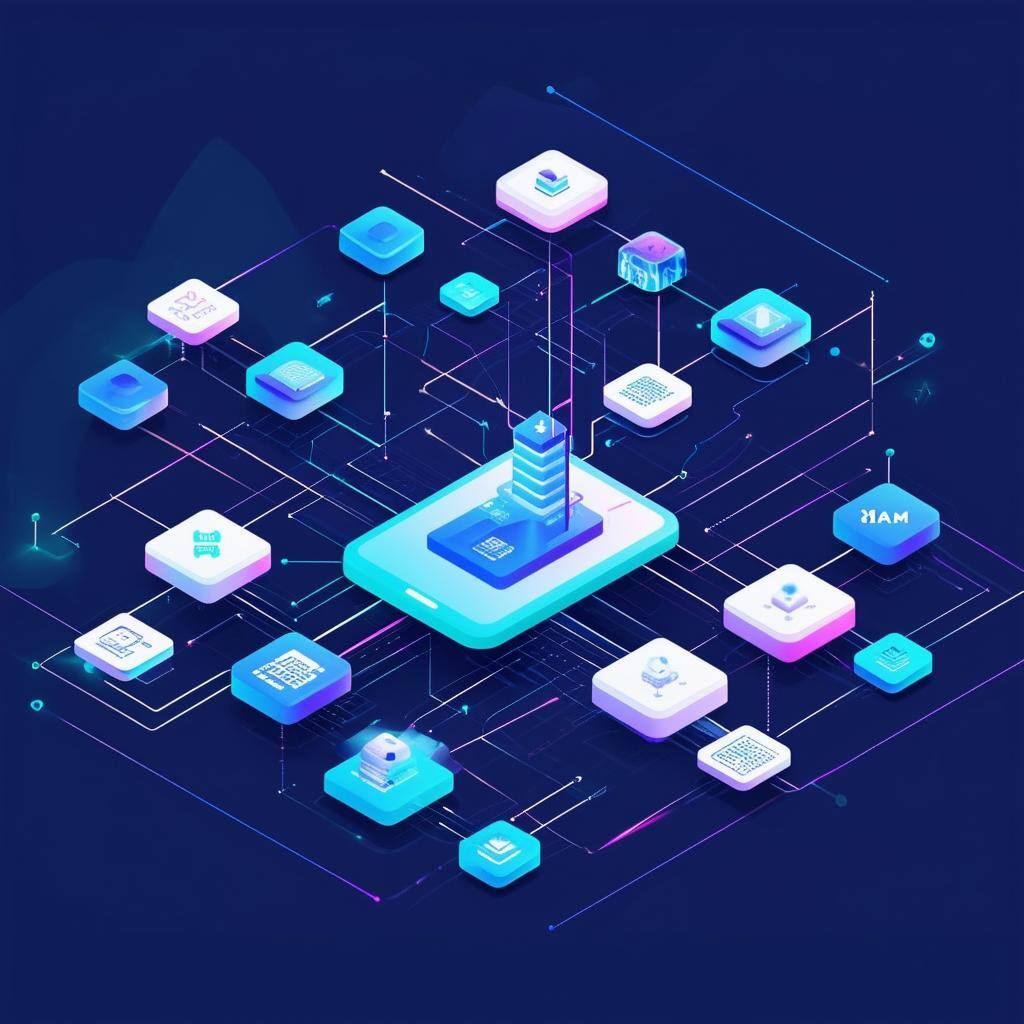Mobile App Architecture Diagram: Essential Components for Efficient Design

They map out the user interface, business logic, and data layers.
A good mobile app architecture diagram helps teams build better apps faster. It shows the flow of data and user interactions.
This makes it easier to spot problems early and fix them. It also helps new team members understand the app quickly.
App architecture diagrams come in different types. Some focus on the big picture, while others zoom in on specific parts.
The best diagrams are clear and easy to read. They use simple shapes and labels that anyone can understand.
Key Takeaways
-
Mobile app architecture diagrams outline the app's structure and components
-
These diagrams help teams build more efficient and user-friendly apps
-
Good architecture planning leads to apps that are easier to update and maintain
Understanding App Architecture
App architecture forms the backbone of mobile applications. It defines how different parts work together to create a functional and efficient app.
Key Principles
Modularity is a core principle of app architecture. It means breaking the app into smaller, independent parts. This makes the app easier to build and maintain.
Separation of concerns is another key idea. It keeps different app functions separate. This helps prevent bugs and makes updating easier.
Scalability is vital for growing apps. Good architecture allows apps to handle more users and features over time.
Patterns and Frameworks
MVC (Model-View-Controller) is a common pattern. It splits the app into three parts: data, display, and logic.
MVVM (Model-View-ViewModel) is another popular choice. It adds a layer between the view and model to improve testing.
Clean Architecture focuses on keeping business logic separate from other parts. This makes apps more flexible and easier to change.
Modular architecture divides apps into reusable modules. Each module can work on its own, making development faster and more efficient.
Core Components of a Mobile App
Mobile apps have three main parts that work together. These parts handle how the app looks, what it does, and where it stores information.
User Interface Layer
The user interface (UI) layer is what people see and touch when using an app. It has screens, buttons, menus, and other visual elements.
This layer aims to make the app easy and fun to use.
Good UI design helps users find what they need quickly. It uses colors, fonts, and layouts that look nice and work well. The UI layer also handles user input like taps and swipes.
Many apps now use tools like Jetpack Compose to build their interfaces. These tools make it easier to create smooth, responsive UIs that work on different screen sizes.
Business Logic Layer
The business logic layer is the brain of the app. It processes data, makes decisions, and carries out the app's main functions.
This layer contains the rules and calculations that make the app work. For example, in a shopping app, it would handle things like:
-
Calculating prices
-
Checking if items are in stock
-
Processing orders
The business logic layer often uses frameworks to organize code and manage dependencies. This helps keep the app running smoothly and makes it easier to update.
Data Layer
The data layer manages how the app stores and retrieves information. It handles tasks like:
-
Saving user preferences
-
Storing app data
-
Connecting to online databases
This layer uses repositories to create a "single source of truth" for the app's data. This means all parts of the app get consistent information.
The data layer also decides when to use local storage on the device or fetch data from the internet. This helps the app work offline and load quickly.
Designing for Scalability and Performance
A well-designed mobile app architecture supports growth and maintains speed as user numbers increase. It balances efficient data handling with smooth user interactions.
Scalable Architecture
Scalable app architecture allows for easy expansion. It uses modular components that can be added or upgraded without disrupting the whole system.
Microservices architecture splits app functions into small, independent services. This makes it easier to scale specific parts of the app as needed. Each service can be updated or scaled separately.
In contrast, monolithic architecture puts all functions in one codebase. This can be simpler to start with but harder to scale later.
Efficient data flow is key for scalability. The app should minimize data transfers and use caching where possible. This reduces server load and speeds up the app.
Optimizing App Performance
Good performance keeps users happy and engaged with the app. Fast load times and smooth interactions are crucial.
Optimize network requests to improve speed. Use efficient communication protocols and compress data when possible. Consider using local storage for frequently accessed data.
Implement lazy loading for images and content. This loads only what's needed, making the app feel faster.
Monitor and optimize battery usage. Background processes should be kept to a minimum. Use push notifications wisely to avoid draining the device battery.
Regular performance testing helps catch issues early. Use tools to measure load times, memory usage, and CPU usage. Fix bottlenecks quickly to maintain a fast, responsive app.
The Role of APIs in Mobile App Architecture
APIs are crucial for connecting mobile apps to external services and data sources. They enable apps to send and receive information, expanding functionality beyond what's stored locally on the device.
API Integration
Mobile apps use APIs to access remote services and data. For example, a weather app might call an API to get current conditions and forecasts. Social media apps use APIs to post updates and retrieve friend lists.
APIs let apps tap into powerful cloud services. This includes things like payment processing, mapping, and language translation. By using APIs, developers can add complex features without building everything from scratch.
Most modern mobile apps rely on multiple APIs. A single app might connect to APIs for user authentication, data storage, and third-party integrations. This modular approach makes it easier to add new features over time.
Securing API Access
API security is vital to protect user data and app functionality. Developers use various methods to keep API connections safe.
One common approach is API keys. These unique codes identify and authorize each app that tries to use an API. Without a valid key, the API will reject requests.
OAuth is another important security standard for APIs. It lets users grant limited access to their data without sharing passwords. This is how many apps let you "Sign in with Google" or post to social media.
Encryption is also key for API security. HTTPS ensures data sent between the app and API servers can't be intercepted. Additional encryption may be used for sensitive information like passwords.
Security and Data Protection Strategies
Mobile apps handle sensitive user data. Strong security measures and data protection are vital for user trust and legal compliance.
Implementing Security Layers
Secure mobile apps use multiple layers of protection. HTTPS encrypts data sent between the app and servers. This stops hackers from stealing info in transit.
App-level encryption adds another shield. It protects data stored on the device and in the cloud. Developers should use strong encryption algorithms.
Authentication methods like passwords, biometrics, or two-factor auth verify user identity. These block unauthorized access to accounts.
Regular security audits help find and fix weak spots. Keeping the app updated patches known vulnerabilities.
Data Privacy and Storage
Apps should only collect needed data. Clear privacy policies tell users how their info is used and stored.
Local device storage is good for offline use. But sensitive data needs extra encryption here.
Cloud storage offers more space and syncing. It requires careful access controls and data separation.
Data should be backed up regularly. But backups need the same level of protection as the main data.
When users delete accounts, all their data should be fully removed. This respects privacy rights and reduces risks.
Cross-Platform and Hybrid Approaches
Cross-platform and hybrid approaches offer ways to build mobile apps that work on different operating systems. These methods aim to save time and money while reaching more users.
Hybrid Mobile App Architecture
Hybrid apps blend web and native technologies. They use HTML, CSS, and JavaScript wrapped in a native container. This allows one codebase to run on both iOS and Android devices.
Hybrid apps are quick to build and easy to update. They work well for simple apps that don't need complex features. But they may not perform as smoothly as native apps for tasks that require a lot of processing power.
Popular frameworks for hybrid apps include Ionic and PhoneGap. These tools let developers create apps that look and feel like native ones.
Native vs Cross-Platform Development
Native apps are built for a specific platform using its unique programming language. Cross-platform apps use a single codebase for multiple platforms.
Native apps often provide the best performance and user experience. They can easily access device features like cameras and sensors. But they take more time and money to develop for each platform.
Cross-platform tools like React Native and Flutter offer a middle ground. They let developers write code once and deploy to both iOS and Android. This approach can be faster and more cost-effective than native development.
Cross-platform apps may not match native performance for very complex apps. But for many businesses, the trade-off in development speed and cost is worth it.
Developing for Maintainability and Testability
Building mobile apps that are easy to maintain and test is key for long-term success. Good practices in these areas save time and reduce bugs.
Code Maintainability
Writing maintainable code starts with a clean, organized structure. Use clear naming for variables, functions, and classes. Keep methods short and focused on one task.
Break the app into modular components. This makes it easier to update specific parts without affecting others. Use design patterns like Model-View-Controller (MVC) to separate concerns.
Document code thoroughly with comments. Explain complex logic and the reasons behind important decisions. This helps other developers understand and work with the code later.
Version control is crucial. Use tools like Git to track changes and collaborate. Create meaningful commit messages to explain updates.
Automated Testing Strategies
Automated tests catch bugs early and give confidence when making changes. Unit tests check individual parts of code in isolation. Write these for core functions and logic.
Integration tests verify that different parts of the app work together correctly. They're especially important for APIs and data flows between components.
UI tests simulate user actions to ensure the interface works as expected. These can catch visual bugs and interaction issues.
Set up continuous integration to run tests automatically when code is pushed. This catches problems quickly before they reach users.
Test coverage tools show which parts of code are tested. Aim for high coverage, especially in critical areas of the app.
Advanced Architectural Considerations
Mobile app architecture requires careful planning for long-term success. Two key areas need special attention: managing dependencies and handling data flow.
Dependency Management
App complexity grows as features are added. Good dependency management keeps the code organized. Developers use tools like Gradle for Android and CocoaPods for iOS. These tools help manage external libraries and internal modules.
Dependency injection is a smart technique. It makes code more flexible and easier to test. Frameworks like Dagger for Android and Swinject for iOS are popular choices. They automate the process of providing objects that a class needs to work.
Using a modular approach helps too. It splits the app into separate parts. This makes the app easier to update and maintain over time.
State Management and Data Handling
Apps need to keep track of data and user actions. This is where state management comes in. It's about controlling how data flows through the app.
For Android, Jetpack Compose offers a modern way to handle state. It uses a reactive approach. The UI updates automatically when data changes.
On iOS, SwiftUI works in a similar way. It uses state holders to keep track of data. When state changes, the UI reflects those changes right away.
For complex apps, dedicated state management solutions help. Redux and MobX are options that work on both platforms. They provide a central place to manage app data.
Caching is important for offline use and speed. SQLite is a common choice for local data storage. It works well on both Android and iOS devices.
Choosing the Right Tech Stack
Picking the right tech stack is key for building great mobile apps. It affects how well the app works and how easy it is to maintain. Let's look at some important parts of a mobile app tech stack.
Frameworks and Libraries
Mobile app frameworks help developers build apps faster. React Native and Flutter are popular choices for making apps that work on both iOS and Android. These frameworks let you write code once and use it on both platforms.
Native frameworks like Swift for iOS and Kotlin for Android give the best performance. They also allow full access to device features. For complex apps, these may be the best choice.
Libraries add extra features to apps. Some common ones are networking libraries for API calls and image loading libraries. Picking the right libraries can save time and improve app quality.
Platform-Specific Technologies
iOS and Android each have their own tools and languages. For iOS, developers use Swift or Objective-C with Xcode.
Android developers use Kotlin or Java with Android Studio.
iOS apps use UIKit or SwiftUI for the user interface. Android apps use XML layouts or Jetpack Compose.
These tools help create the look and feel of the app.
Each platform has its own way of handling data and background tasks. iOS uses Core Data and Grand Central Dispatch.
Android uses Room database and Coroutines. Knowing these differences is important for building efficient apps.
Implementation and Deployment
Building and releasing a mobile app involves careful planning and execution. Developers must integrate components, test thoroughly, and navigate app store requirements.
Building and Integrating App Components
App developers start by coding individual features based on the architecture design. They create user interfaces, implement business logic, and set up data storage.
Integration testing ensures all parts work together smoothly.
Version control systems like Git help track changes and allow team collaboration. Continuous integration tools run automated tests when new code is added.
This catches bugs early and maintains app quality.
Developers use build tools to compile the app for different platforms. For iOS, Xcode creates the final package.
Android apps use Gradle for building. These tools optimize code and prepare it for distribution.
Publishing on App Stores
Before submitting an app, developers must follow each store's guidelines.
Apple's App Store and Google Play have strict rules about content, design, and functionality.
App store listings need clear descriptions, screenshots, and icons. Developers set pricing and choose which countries to release in.
They also handle age ratings and content warnings.
The submission process involves uploading the app package and waiting for approval.
Reviewers check for policy violations and technical issues. If problems are found, developers must fix them and resubmit.
Once approved, the app goes live on the store.
Developers can track downloads, ratings, and user feedback. Regular updates keep the app running smoothly and add new features.







